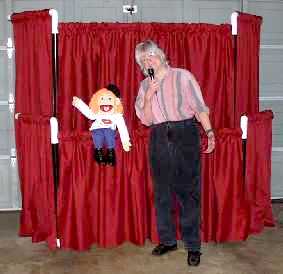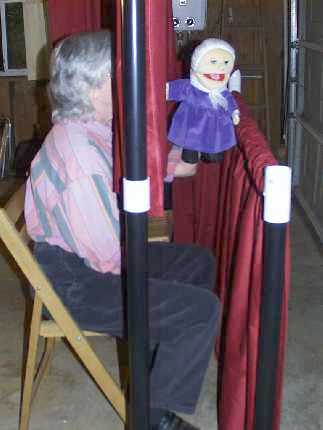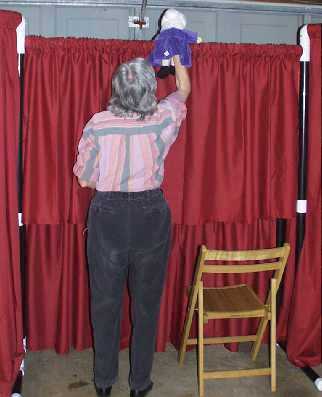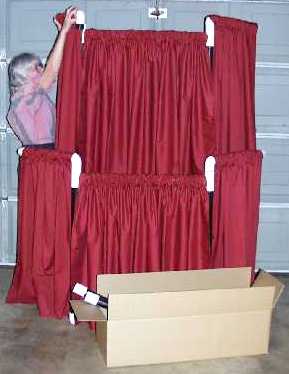
QUESTIONS & ANSWERS
#1004 CLASSROOM PUPPET STAGE

QUESTION: It's hard to tell from your
illustrations exactly how big the Classroom Stage is. Can
you tell me the specifications?
ANSWER: The Classroom stage is 77 inches tall from the floor to the top of the swing arms that hold the side curtains. The stage is 64 inches wide between the swing arms but with the swing arms angled out in the recommended fashion, the width of the stage effectively becomes 8 feet. There are six curtains in all, four for the side swing arms, one for the stage front and one for the stage backdrop. The stage structure (not counting the curtains) consists of sixteen pieces, most marked with a color dot for quick, easy assembly. Unassembled, the components (including the curtains) fit into a 10” x 12” x 36” box. Shipping weight is 22 lbs.
QUESTION: When we put on a show, people standing around can see our arms going up into the puppets. Any suggestions on how to keep the audience from seeing us?
 ANSWER:
The proper viewing angle from the audience should be with eye
level at (or lower than) the top of the front curtain. The
bottom of the back curtain hangs below the top of the front
curtain, hopefully preventing the audience from seeing the
puppeteer or the puppeteer's arms. The Classroom stage was
designed with certain general considerations, not unbreakable
rules, which allow it to be used professionally and easily by
children or adults. It is designed to accommodate 2-3
puppeteers, seated on normal-height chairs (such as folding
chairs). If more than three puppeteers have their puppets
on-stage at the same time, it would probably be better to do away
with the chairs altogether. In this case, a mat should be
placed on the floor for the puppeteers to kneel on while working
their puppets. The puppets should do their acting in
the space between the backdrop curtain and the top of the front
curtain, making sure to stay low enough so that the audience
cannot see the puppeteer's arms. In the photo on the right, the
right swing arms have been removed to better view the
normal puppet operating position. In the photo below, the puppet
is being operated over the top of the backdrop curtain.
ANSWER:
The proper viewing angle from the audience should be with eye
level at (or lower than) the top of the front curtain. The
bottom of the back curtain hangs below the top of the front
curtain, hopefully preventing the audience from seeing the
puppeteer or the puppeteer's arms. The Classroom stage was
designed with certain general considerations, not unbreakable
rules, which allow it to be used professionally and easily by
children or adults. It is designed to accommodate 2-3
puppeteers, seated on normal-height chairs (such as folding
chairs). If more than three puppeteers have their puppets
on-stage at the same time, it would probably be better to do away
with the chairs altogether. In this case, a mat should be
placed on the floor for the puppeteers to kneel on while working
their puppets. The puppets should do their acting in
the space between the backdrop curtain and the top of the front
curtain, making sure to stay low enough so that the audience
cannot see the puppeteer's arms. In the photo on the right, the
right swing arms have been removed to better view the
normal puppet operating position. In the photo below, the puppet
is being operated over the top of the backdrop curtain.
QUESTION: What kind of lighting should we use so as not to be seen behind the stage?
 ANSWER: As much
lighting as possible should be on the front of the stage, with as
little light as possible behind the stage. This will allow
the puppeteers to clearly see the puppets through the backdrop
curtain without the audience seeing the puppeteers. A
classroom, for instance, is often the poorest location for
puppeteers to remain unseen, largely due to the uniform ceiling
lighting and large window areas. To make a classroom or
other room suitable for a puppet show, first set up the stage
with a blank, dark wall behind it (windows should be curtained or
cloaked). Darken the room as much as possible. A desk
lamp or two (with the adjustable swivel or gooseneck if possible)
can be placed to either side of the stage so that they shine
directly on the front of the stage. If just normal table
lamps are used, something should be hung on the shades so that
the light doesn't shine back into the eyes of the audience.
Lastly, the puppeteers should wear dark clothing. Black
absorbs the light while white reflects it. Some puppeteers
cut the feet off of black socks and pull them over their arms
before putting on the puppets.
ANSWER: As much
lighting as possible should be on the front of the stage, with as
little light as possible behind the stage. This will allow
the puppeteers to clearly see the puppets through the backdrop
curtain without the audience seeing the puppeteers. A
classroom, for instance, is often the poorest location for
puppeteers to remain unseen, largely due to the uniform ceiling
lighting and large window areas. To make a classroom or
other room suitable for a puppet show, first set up the stage
with a blank, dark wall behind it (windows should be curtained or
cloaked). Darken the room as much as possible. A desk
lamp or two (with the adjustable swivel or gooseneck if possible)
can be placed to either side of the stage so that they shine
directly on the front of the stage. If just normal table
lamps are used, something should be hung on the shades so that
the light doesn't shine back into the eyes of the audience.
Lastly, the puppeteers should wear dark clothing. Black
absorbs the light while white reflects it. Some puppeteers
cut the feet off of black socks and pull them over their arms
before putting on the puppets.
QUESTION: Can the stage
be made bigger or smaller, to accomodate more or fewer
puppeteers?
ANSWER: The crossbars that support the front and backdrop curtains may be installed at half-length to provide a stage area of about 30 inches between the swing arms. This arrangement is often suitable for areas with less space, or for presentations given by a single puppeteer. The photo on the right shows the stage set up in this minimum configuration. We do not advise extending the crossbars beyond the standard configuration shown in all of the photos above for two reasons: #1) The crossbars may tend to bend and separate if spanning a distance greater than they were designed for, thus making the stage less stable; #2) While the curtains may be stretched to some degree along an extended crossbar, they will certainly lose their fullness which affects both their attractiveness and their ability to conceal the puppeteers.
QUESTION: What colors does the stage come in?
ANSWER: The curtains are designed to exactly fit this stage and to allow the puppeteer's to view the puppets (and to a lesser extent, the audience) through them. This see-through quality of the curtains is accomplished by a combination of the material, the special colors used and the lighting provided at the location the stage will be used (see Question #3, above). The color of the curtains shown in the photos here is Burgundy. Also available are: Forest Green, Navy Blue and Midnight Black.
 QUESTION:
How hard is this stage to set up, and what tools will I need?
QUESTION:
How hard is this stage to set up, and what tools will I need?
ANSWER: There are 16 components to the stage, most having a COLOR DOT to assist with assembly. The components are designed to be hand-fitted together and no tools are necessary, though the Assembly Instructions do suggest using a light hammer to tap the fittings together under some circumstances. The brief step-by-step instructions should have your stage out of the box and completely set up within 10 minutes. Expect it to take slightly longer the first time until you become familiar with the components and their placement.
The Assembly Instructions also suggest using wire coat hangers, which may be bent into hooks, to hang puppets behind the front curtains or to hang scenery in front of the back curtains.